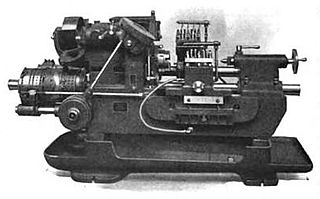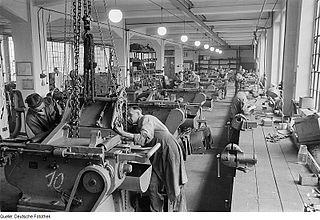History
In the late 18th century, French General Jean Baptiste Vaquette de Gribeauval suggested that muskets could be manufactured faster and more economically if they were made from interchangeable parts. This system would also make field repairs easier to carry out under battle conditions. He provided patronage to Honoré Blanc, who attempted to implement the Système Gribeauval, but never succeeded. [2] Until then, under the British factory system, skilled machinists were required to produce parts from a design. But however skilled the machinist, parts were never identical, and each part had to be manufactured separately to fit its counterpart—almost always by one person who produced each completed item from start to finish.
Mass production using interchangeable parts was first achieved in 1803 by Marc Isambard Brunel in cooperation with Henry Maudslay, and Simon Goodrich, under the management of (with contributions by) Brigadier-General Sir Samuel Bentham, the Inspector General of Naval Works at Portsmouth Block Mills at Portsmouth Dockyard, for the British Royal Navy during the Napoleonic War. By 1808 annual production had reached 130,000 sailing blocks. [4] [5] [6] [7] [ page needed ] [8] [ page needed ] [9] [ page needed ] [10] [ page needed ] [11] [ page needed ] [12] [13] This method of working did not catch on in general manufacturing in Britain for many decades, and when it did it was imported from America, becoming known as the American System of Manufacturing, even though it originated in England.
The Lowell system is also related to the American system during this time. It emphasized procuring, training, and providing housing and other living necessities for the workforce, as well as using semi-automated machines in a centralized factory building or complex.
Gribeauval's idea was conveyed to the US by two routes. First, Blanc's friend Thomas Jefferson championed it, sending copies of Blanc's memoirs and papers describing his work to Secretary of War Henry Knox. Second, artillery officer Louis de Tousard (who had served with Lafayette) was an enthusiast of Gribeauval's ideas. Tousard wrote two influential documents after the American Revolution; one was used as the blueprint for West Point, and the other became the officer's training manual. [2]
The War Department, which included officers trained at West Point on Tousard's manual, established the armories at Springfield and Harper's Ferry and tasked them with solving the problem of interchangeability. The task was finally accomplished in the 1820s. Historian David A. Hounshell believes that this was done by Captain John H. Hall, an inside contractor at Harper's Ferry. [2] In a letter dated 1822 Hall makes the claim he had achieved interchangeability in that year. [14] But historian Diana Muir argues that it is more probable that it was Simeon North, a Connecticut arms contractor manufacturing guns for the US Army. North, not Hall, was the inventor of the crucial milling machine in 1816, and had an advantage over Hall in that he worked closely with the first industry that mass-produced complex machines from mass-produced interchangeable parts, the Connecticut clock-making industry. [15] [ page needed ] By 1815 the idea of interchangeability was well established in the US government system of procurement; Congressional contracts stipulated this quality in muskets, rifles and pistols ordered after that date. [16] Interchangeability of firearms parts at the U.S. armories was found to have been in use for a number of years by the time of the 1853 British Parliamentary Commissions Committee on Small Arms inquiry. [2]
The "American method" was reintroduced to the UK in the 1850s, when Colt executed on order on naval revolvers in Pimlico, and strikes of London and Birmingham gunmakers during the war made the War Office realize the usefulness of being able to employ low-skilled workers, so milling machines were bought and installed at the Royal Small Arms Factory by 1857. [17]
A critical factor in making interchangeable metal parts was the invention of several machine tools, such as the slide rest lathe, screw cutting lathe, turret lathe, milling machine and metal planer. One of the most important and versatile of these machine tools was David Wilkinson's lathe, for which he received a $10,000 award from the government of the United States. [18] [ page needed ]
Eli Whitney is generally credited with the idea and the practical application, but both are incorrect attributions. Based on his reputation as the inventor of the cotton gin, the US government gave him a contract in 1798 for 10,000 muskets to be produced within two years. It actually took eight years to deliver the order, as Whitney perfected and developed new techniques and machines. In a letter to Treasury Secretary Oliver Wolcott apologizing for the delays, Whitney wrote:
One of my primary objectives it to form tools so the tools themselves shall fashion the work and give to every part its just proportion – which when once accomplished, will give expedition, uniformity, and exactness to the whole... In short, the tools which I contemplate are similar to engraving on a copper plate from which may be taken a great number of impressions, perfectly alike. [14] [ page needed ]
Whitney did use machinery; however, there is no evidence that he produced any new type of metalworking machinery. [14] After completing the initial contract, Whitney went on to produce another 15,000 muskets within the following two years. Whitney never actually expressed any interest in interchangeability until 1800, when Treasury Secretary Wolcott exposed him to the memoirs of Blanc, [2] but he spent far more time and energy promoting the idea than developing it.
In order to spread knowledge of manufacturing techniques, the War Department made contractors open their shops to other manufacturers and competitors. The armories also openly shared manufacturing techniques with private industry. [18] Additionally, the idea migrated from the armories to industry as machinists trained in the armory system were hired by other manufacturers. Skilled engineers and machinists thus influenced American clockmakers and sewing machine manufacturers Wilcox and Gibbs and Wheeler and Wilson, who used interchangeable parts before 1860. [2] [19] Late to adopt the interchangeable system were Singer Corporation sewing machine (1870s), reaper manufacturer McCormick Harvesting Machine Company (1870s–80s) [2] and several large steam engine manufacturers such as Corliss (mid-1880s) [20] as well as locomotive makers. Large scale of production of bicycles in the 1880s used the interchangeable system. [2]
The idea would also help lead to the American "Golden Age" of manufacturing when Ransom E. Olds mass-produced the Curved Dash automobile starting in 1901. Henry Ford did not start mass producing cars until 1913. Mastering true interchangeability on the assembly line, the Ford plant produced standard model cars. These efficient production strategies allowed these automobiles to be affordable for the middle class.
Pre–Industrial Revolution
This article needs additional citations for verification .(November 2006) |
The idea of interchangeable parts and the separate assembly line was not new, though it was little used. The idea was first developed in East Asia during the Warring States period and later the Qin Dynasty over 2200 years ago – bronze crossbow triggers and locking mechanisms were mass-produced and made to be interchangeable. Venice during the late Middle Ages had ships that were produced using pre-manufactured parts, assembly lines, and mass production. The Venetian Arsenal apparently produced nearly one ship every day, in what was effectively the world's first factory.
















